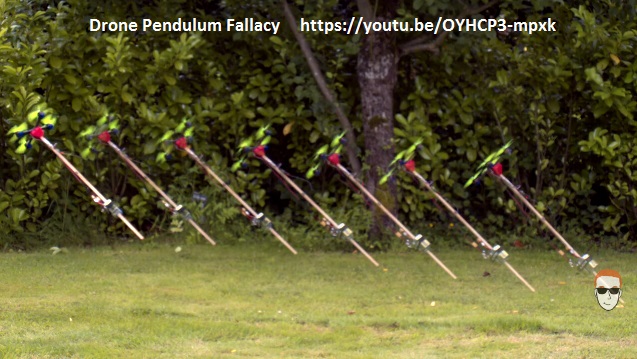Hello all.
Question:
Can the average person apply the required “corrections” to keep the Portable Flyer under control?
or:
Has the pilot of the Portable Flyer to be as strong, lightweight and flexible as the Olympic champion on rings?
The Portable Flyer on the air is like a seesaw at equilibrium:

- Equilibrium in a seesaw comes when the moment of the weight of the one child times its horizontal distance from the central pivot equals to the moment of the weight of the other child times its horizontal distance from the same central pivot
Freeze the pilot and leave the Portable Flyer to fly on the air.
The set (Portable Flyer / frozen pilot) has no tendency to change its initial direction of flight (defined as, say, the direction of a propeller axis). This is what the
“Pendulum Rocket Fallacy” says, and this is what the following image:

demonstrates in practice (more at pages 212 and 213 of this discussion).
It doesn’t matter if the pilot is under the propellers or above or at the side of the propellers, it doesn’t matter if the center of gravity is higher or lower, the Portable Flyer with the frozen pilot tends to keep its direction of flight.
- Worth to mention here:
The Portable Flyer with the frozen pilot will slowly change its direction, but a significant change (say for 15 degrees) will take time το happen and will be at “random” direction; and without corrections the set will eventually hit the ground.
Back to the seesaw:
Take a seesaw at equilibrium, with two heavy adults (say, 100Kg each) seating at the ends of its 4m long board. In order to vary the angle of the board of the seesaw from horizontal to 10 degrees clockwise, what is required is a tiny torque (or moment).
Even with 1mN of torque, the seesaw will turn (suppose the central pivot is supported on roller bearings).
It is easy to calculate how long it will take the 10 degrees rotation.
- EDIT
Even with two elephants sitting at the ends of the seesaw board, the 1mN torque can turn the board.
To take an idea of what 1mN of torque is: by leaning your head (it is about 5Kg / 50N) to the side, your neck is loaded by a torque of 50N * 0.1m = 5mN.
I.e. just by leaning his head, the pilot of the Portable Flyer has 5mN of torque for corrections / control of his flight
EDIT
The smaller the torque applied, the slower the variation of the board angle.
If the acting torque (control input?) doubles, the required time (for the same 10 degrees turn) halves.
So,
on one hand the Portable Flyer with the frozen pilot tends to keep its direction of flight, on the other hand in order to keep the direction of flight unchanged for hours what is required is a small torque that cancels out the small changes of the direction of flight before they become significant in amplitude (
sorry for my “salad English”, but with a little dose of good will I am sure you will understand what the point is).
So,
if the pilot of the Portable Flyer is not going to make aerobatics or fast “changes” of the flight mode, any person – no matter how heavy or weak they are - can keep the control and make the basics on the air: i.e. to take off, to hover, to cruise at the desirable direction at affordable speed and to land safely (say, as an old or heavy person can stand and walk, but cannot run or make loops).

If something is not clear, please let me know to further explain.
Thanks
Manolis Pattakos







